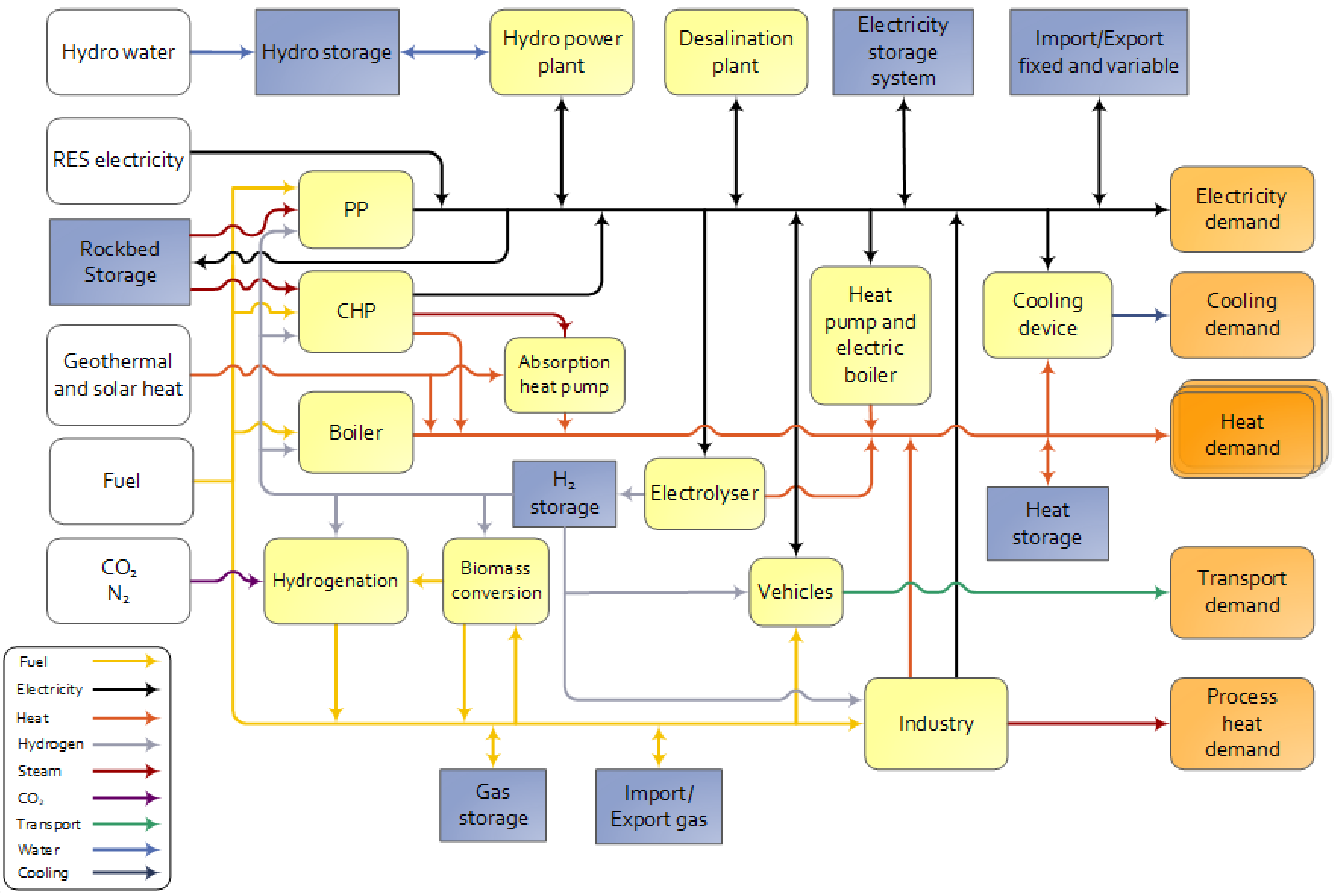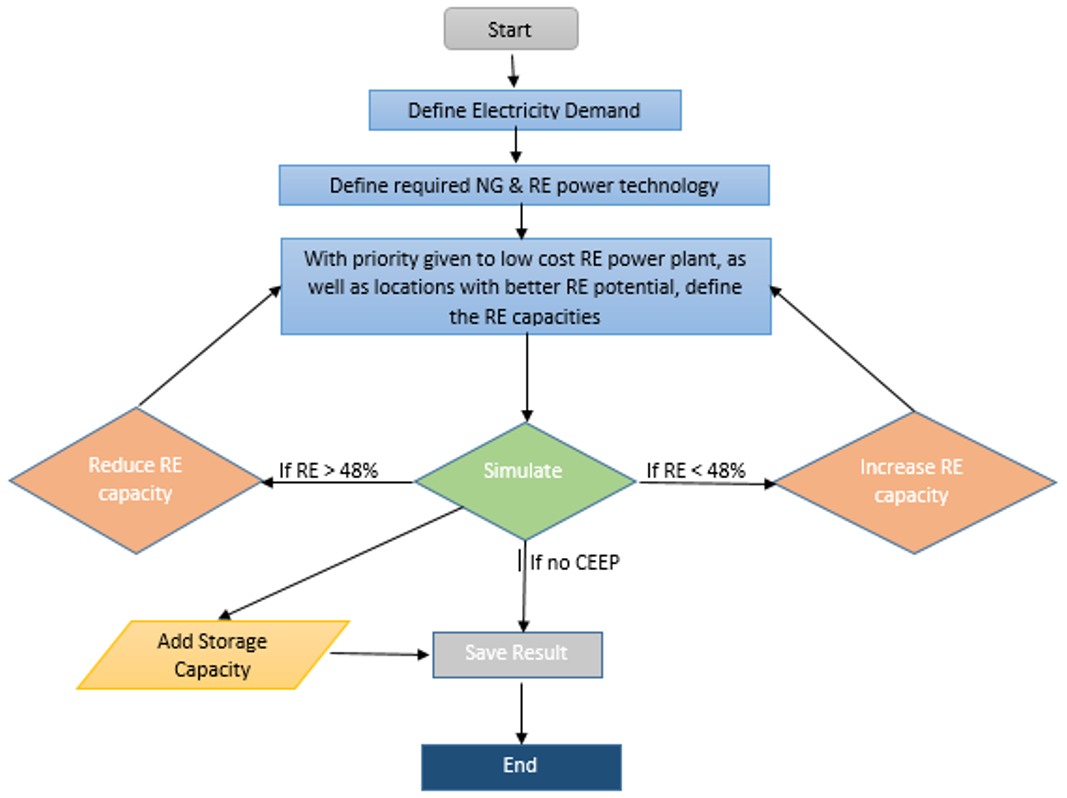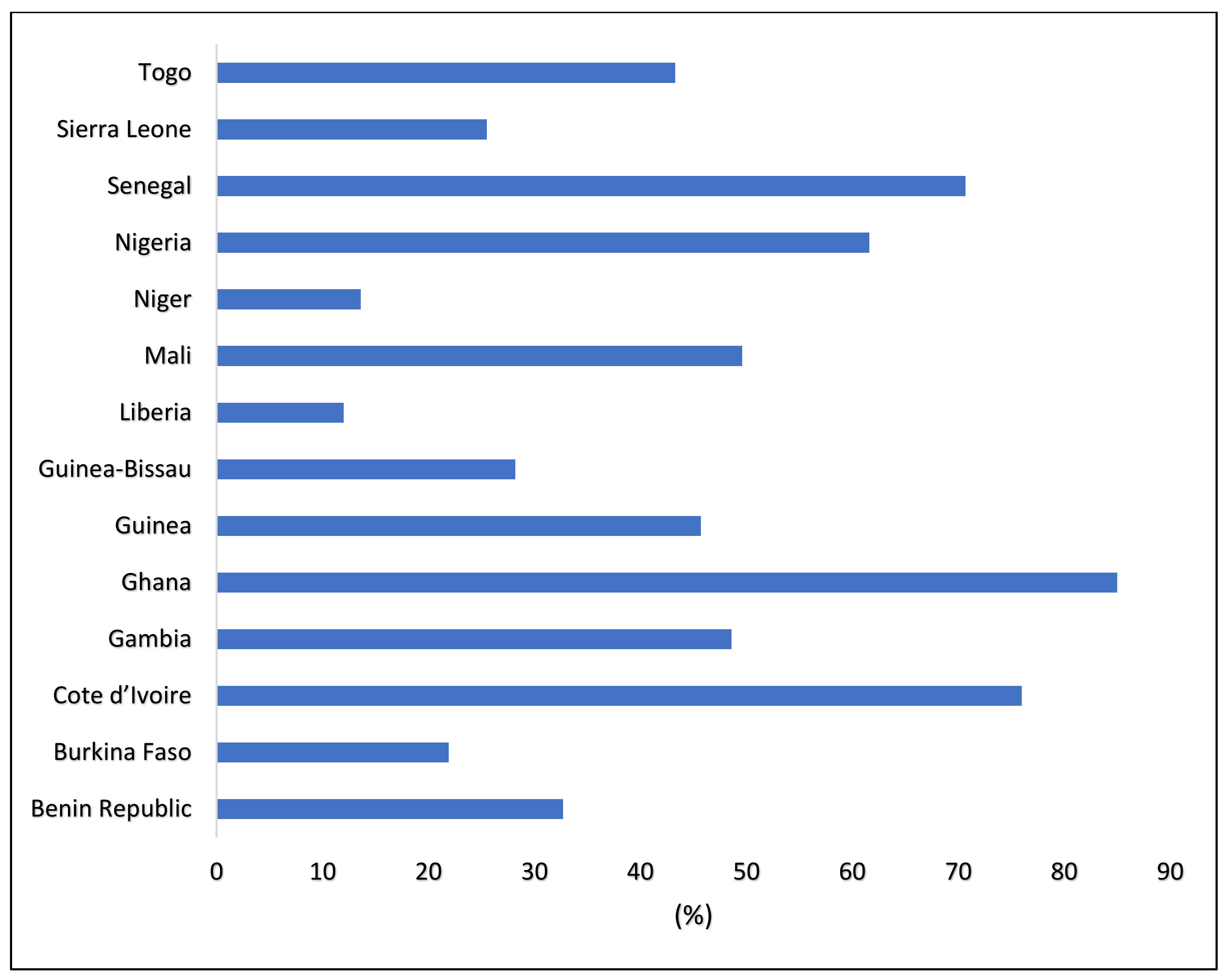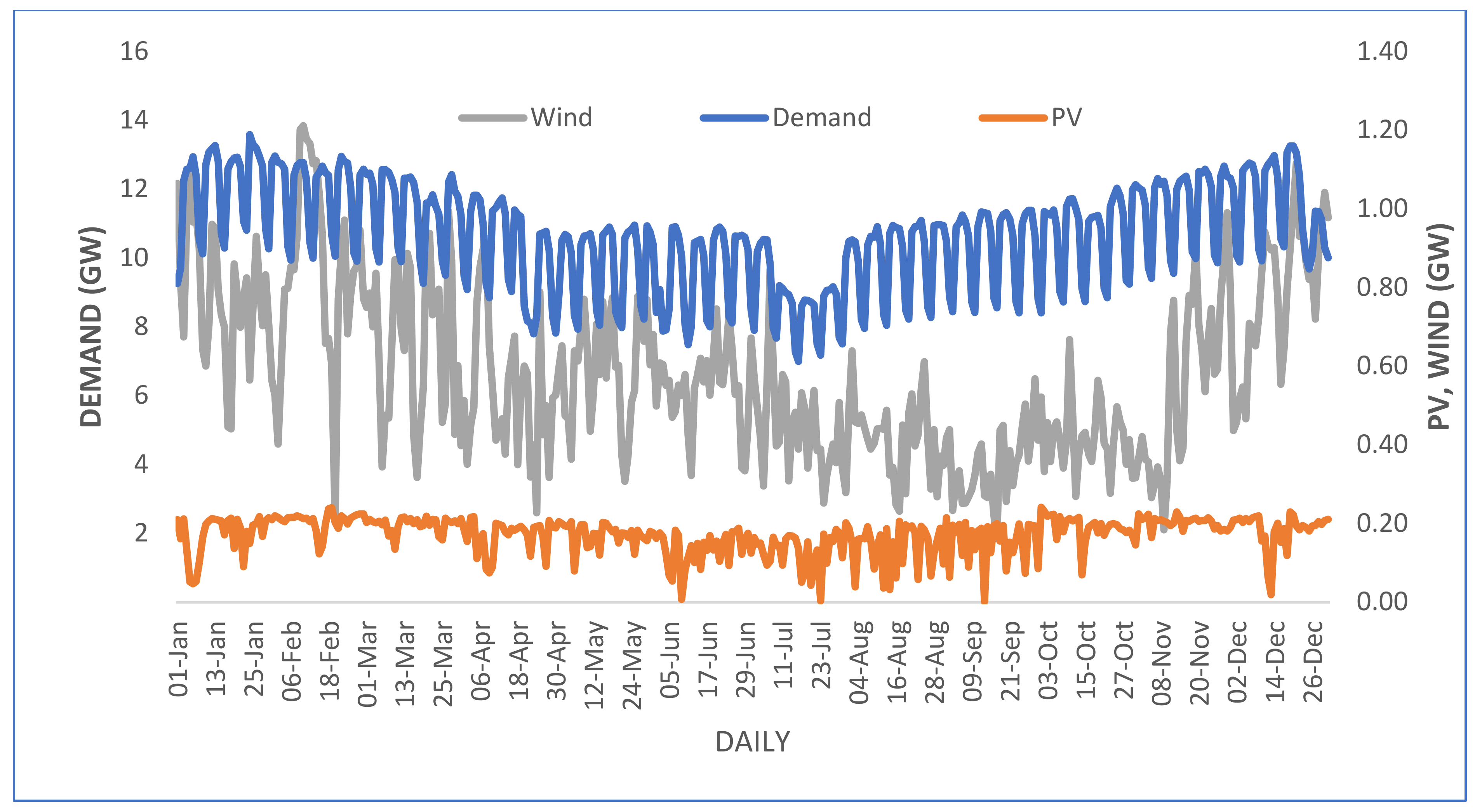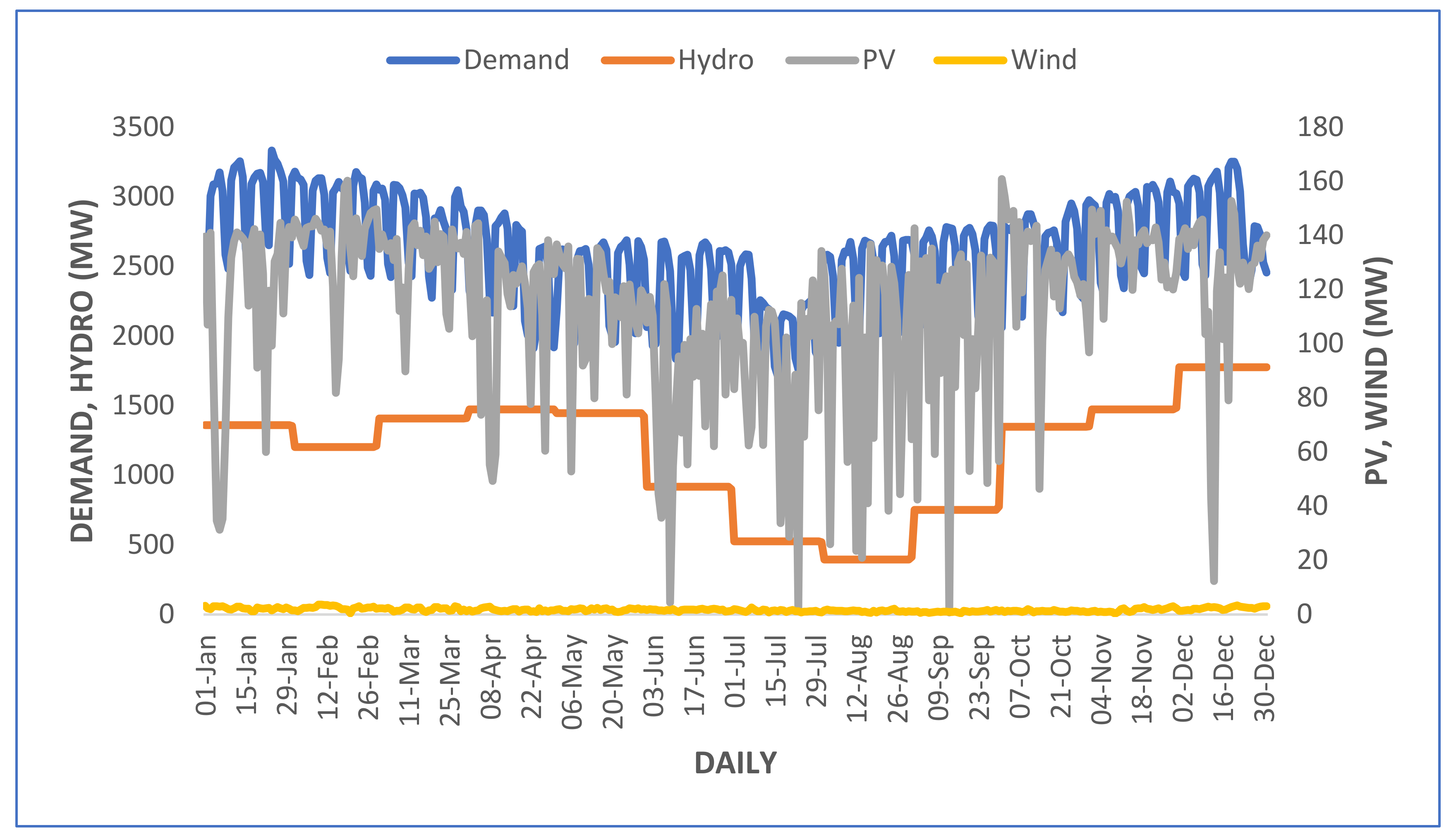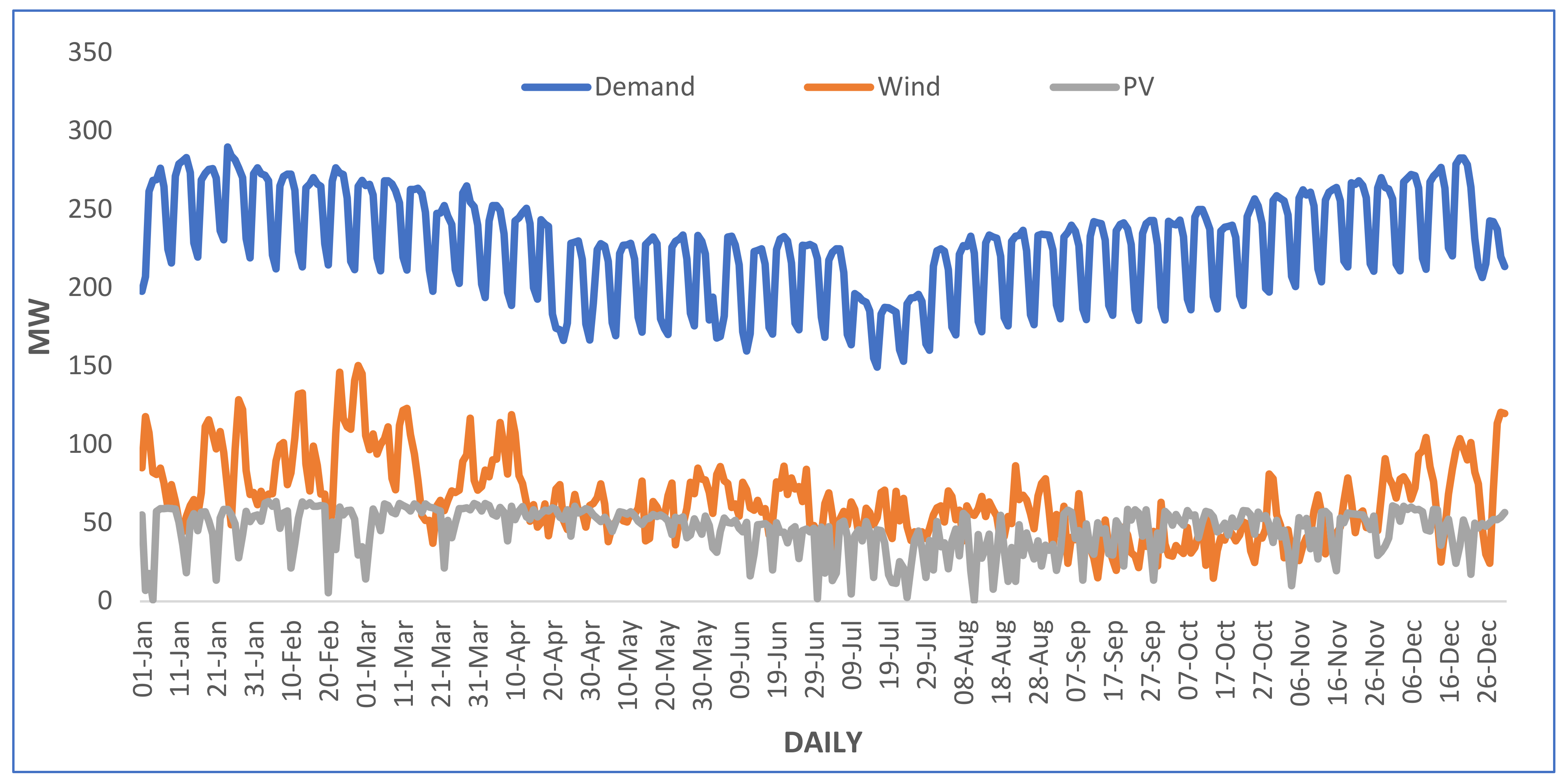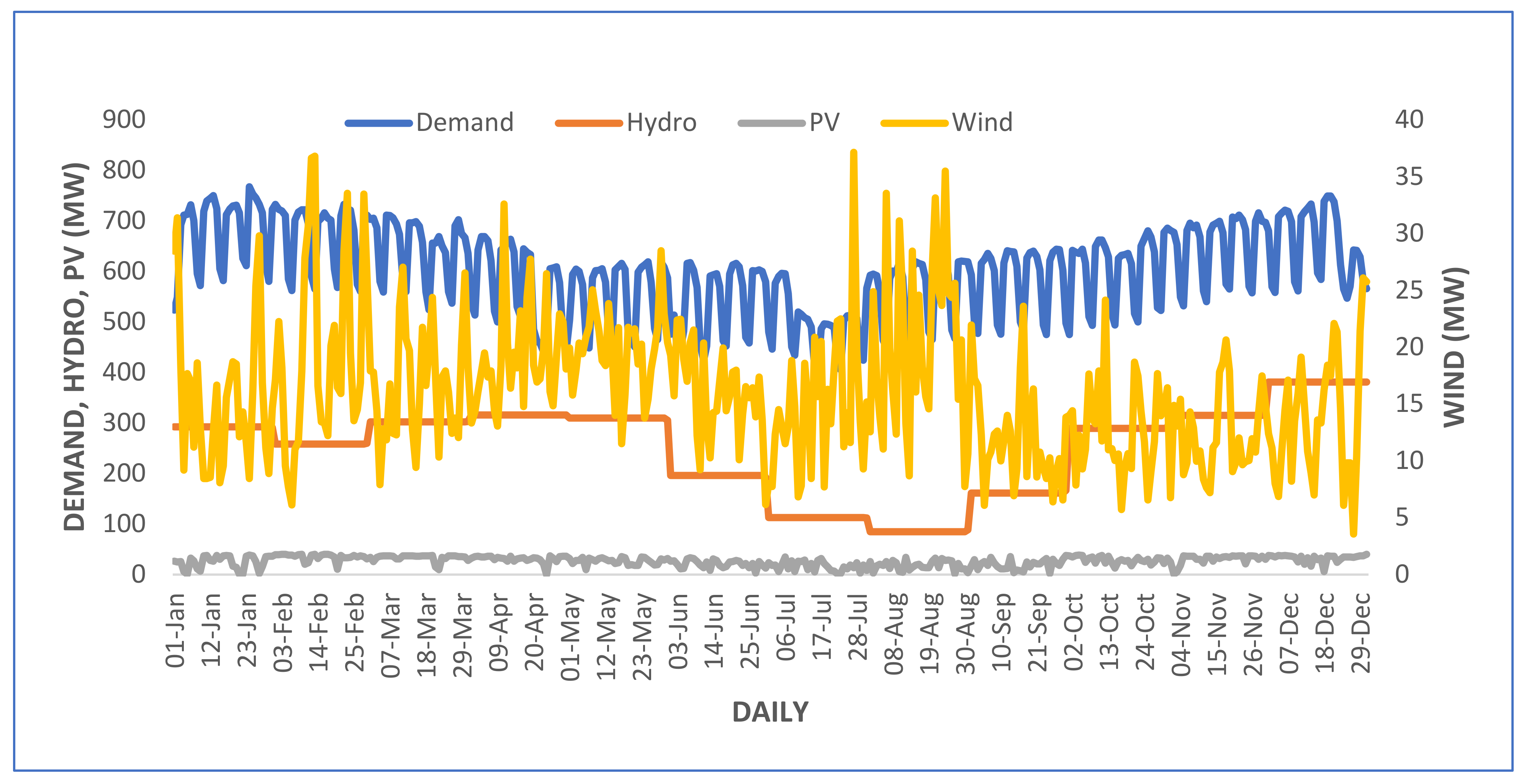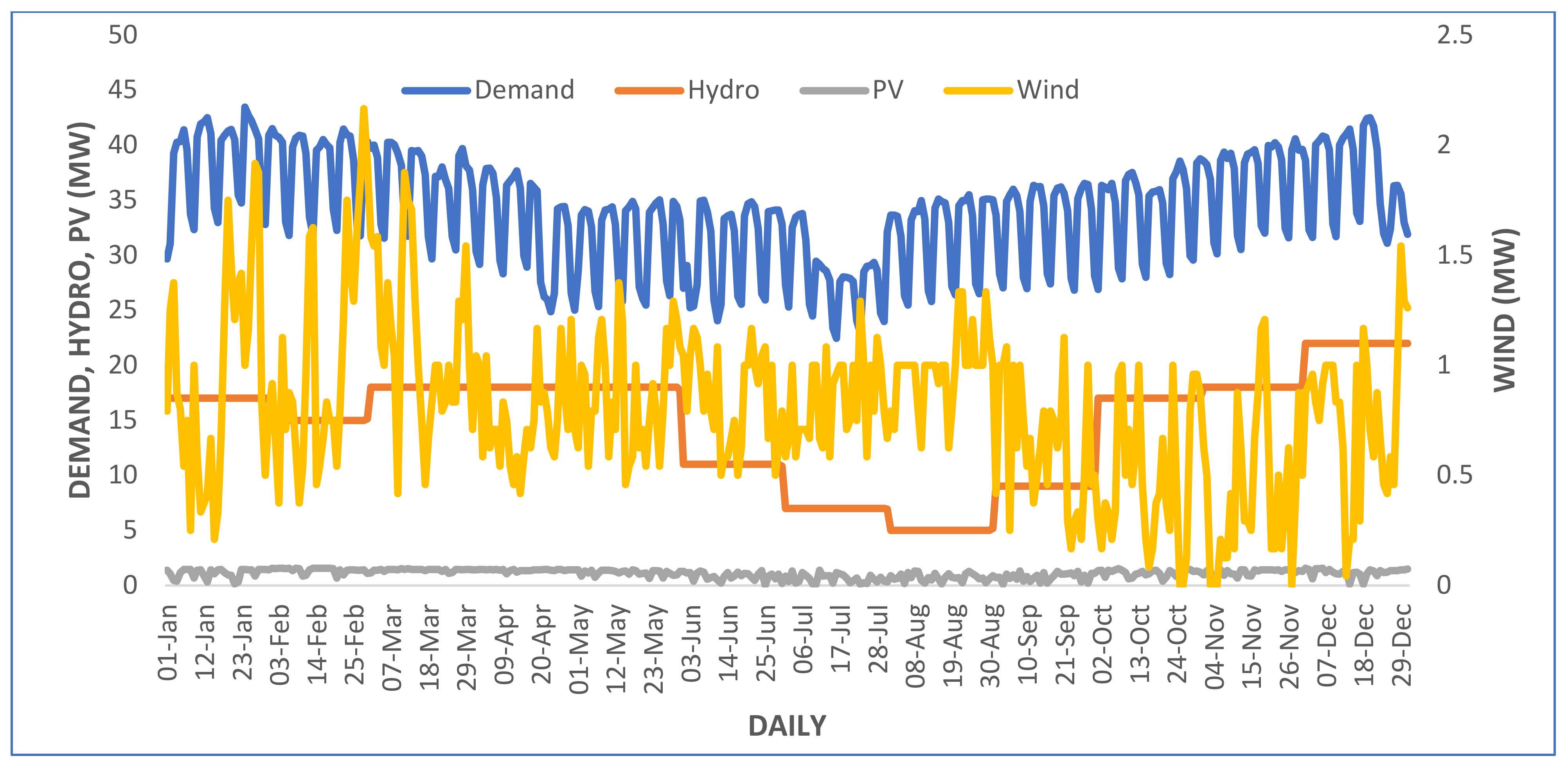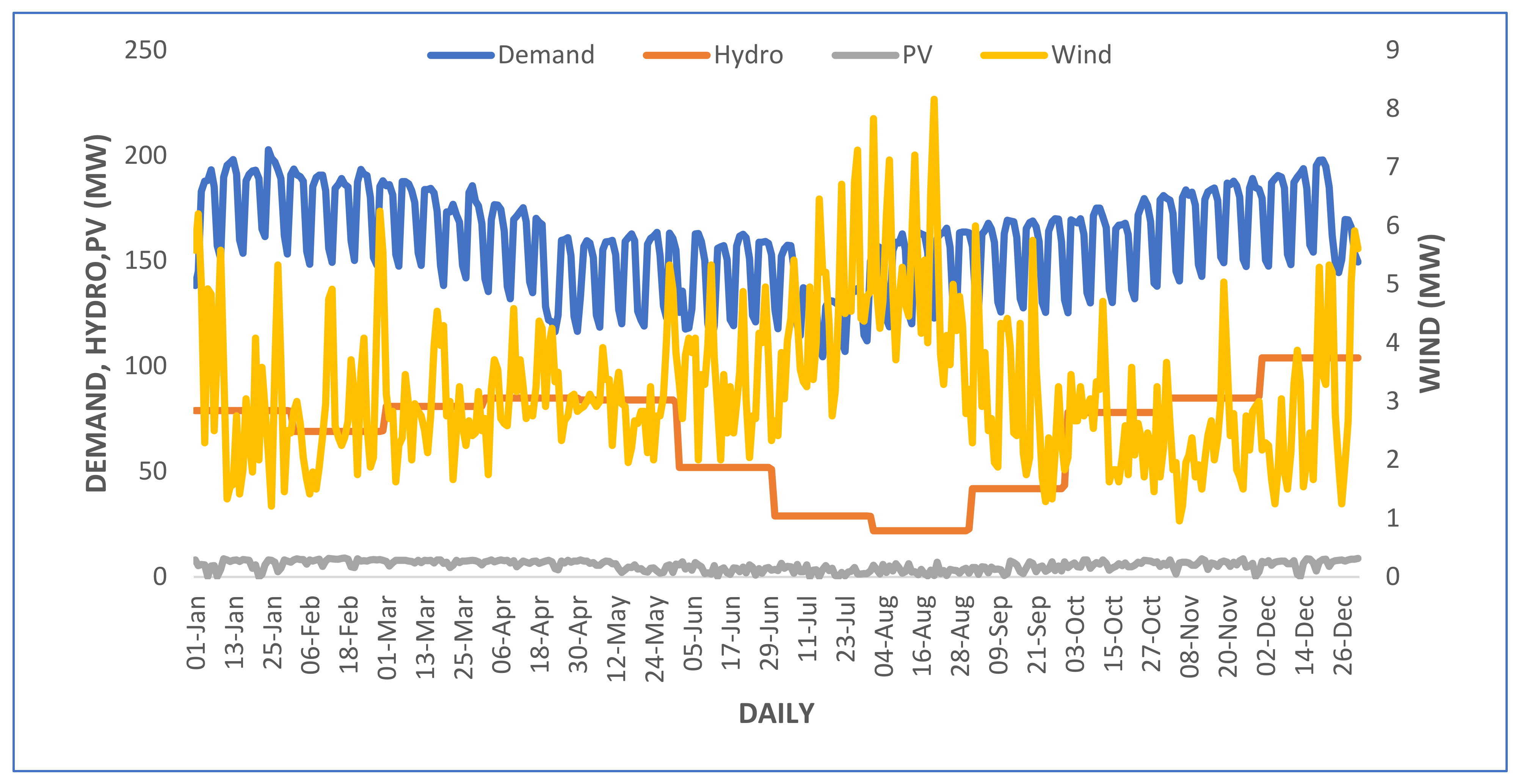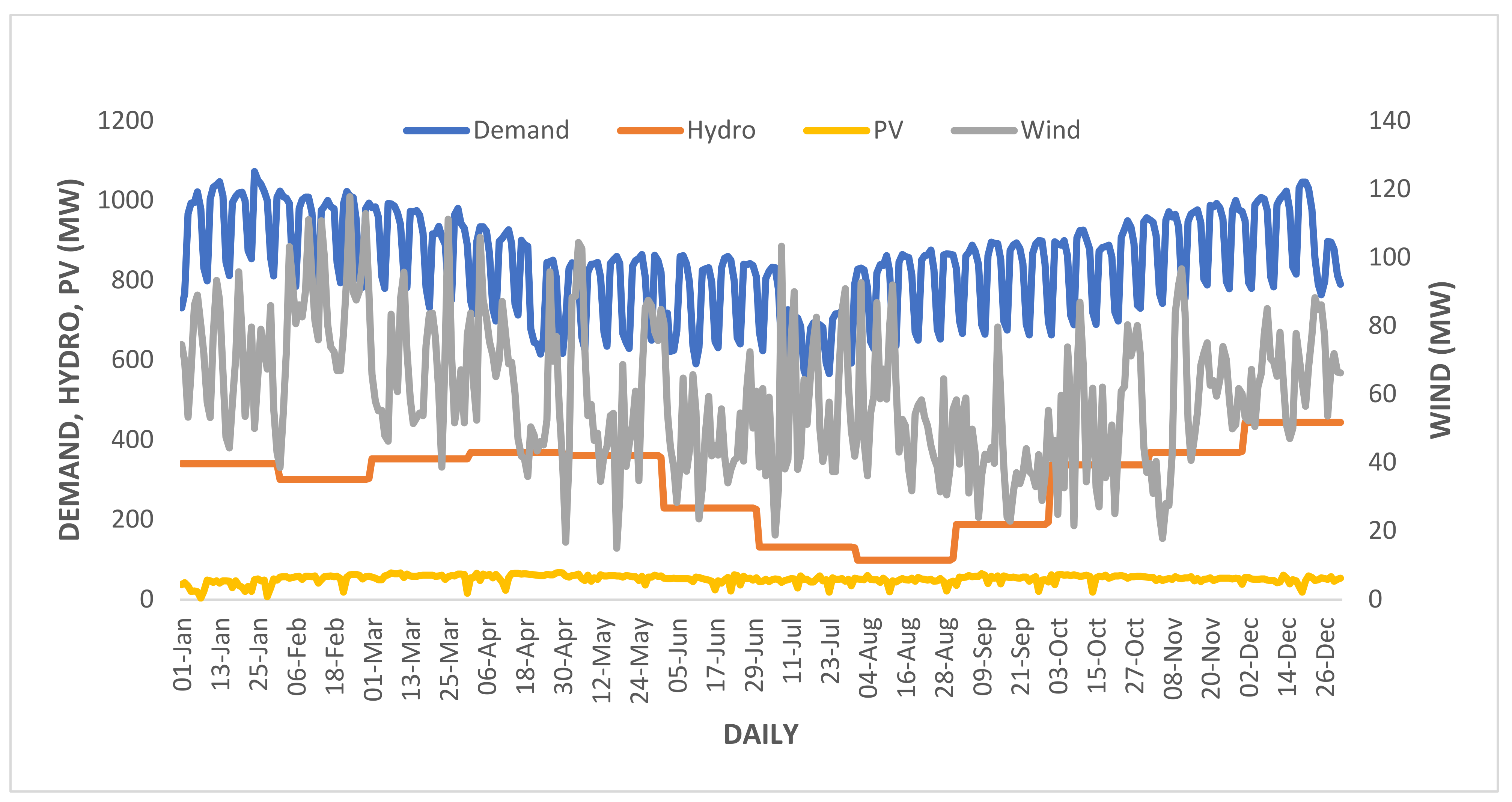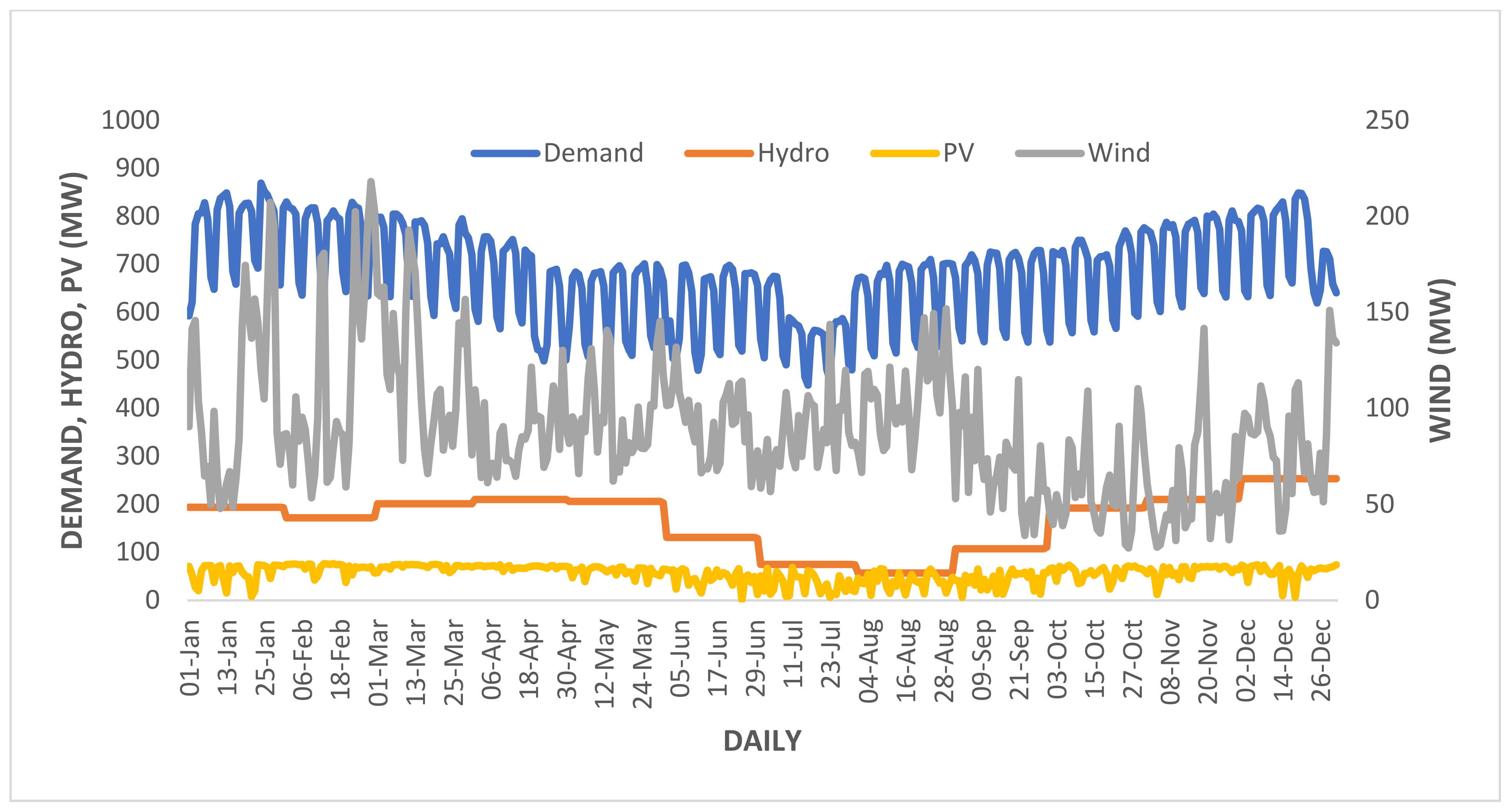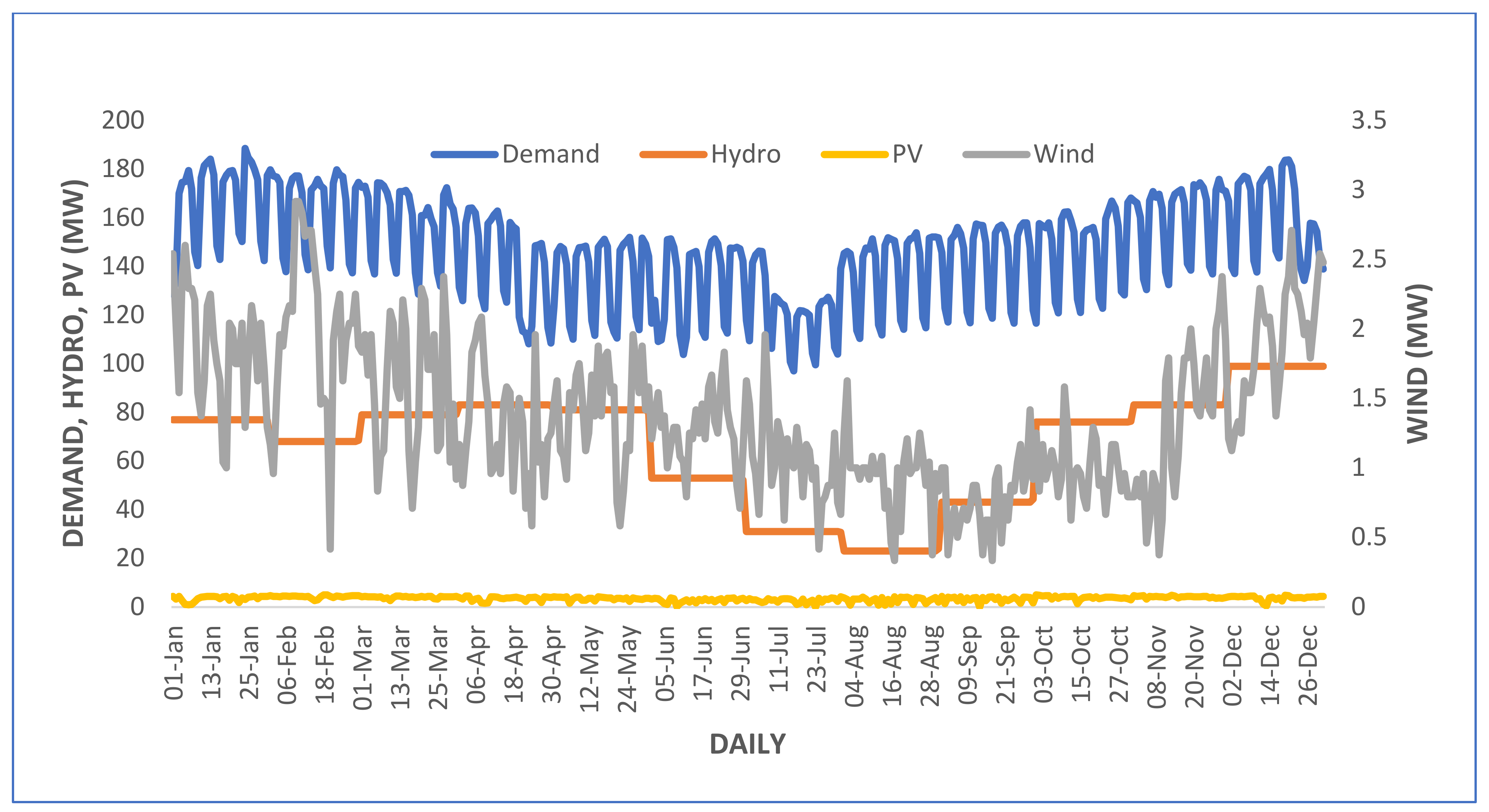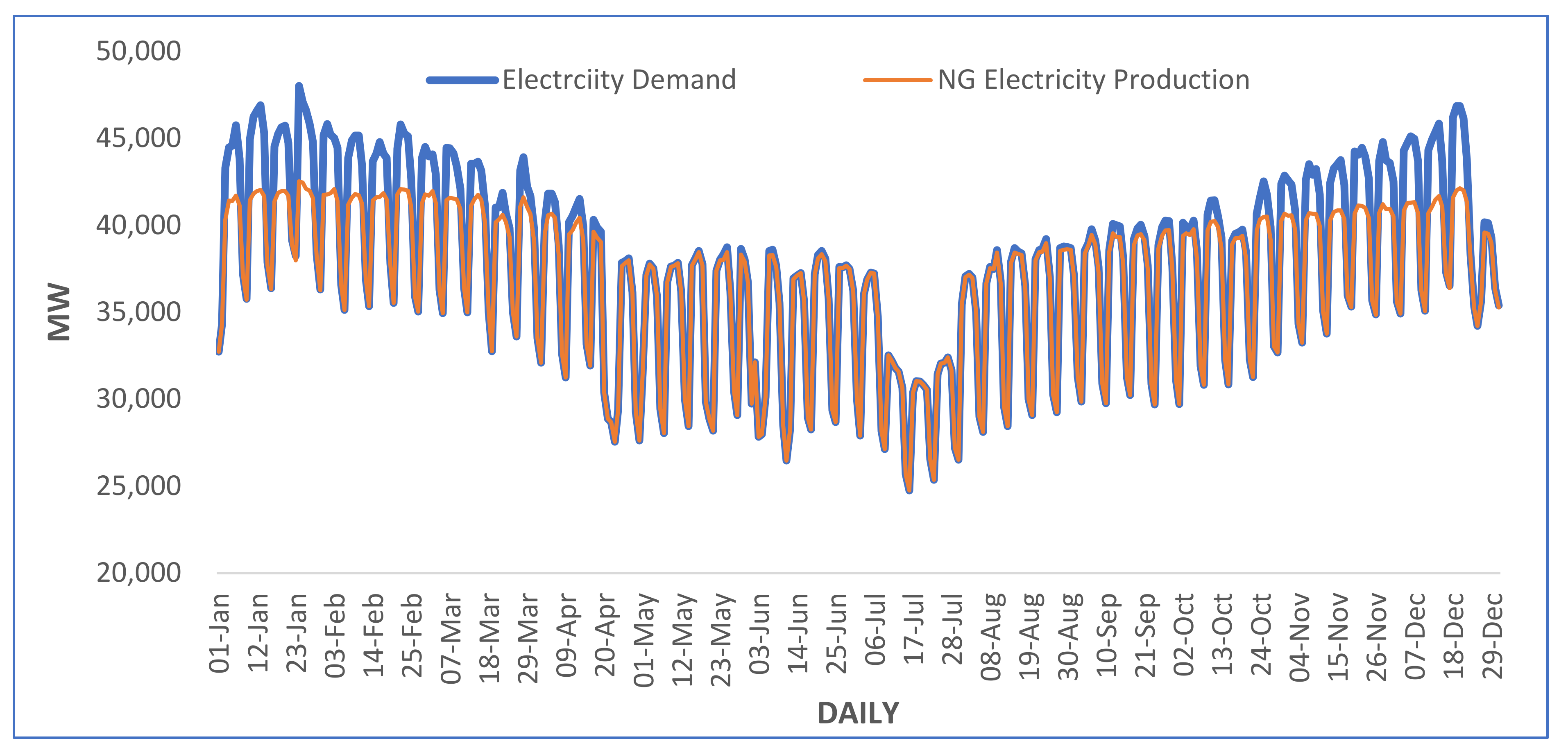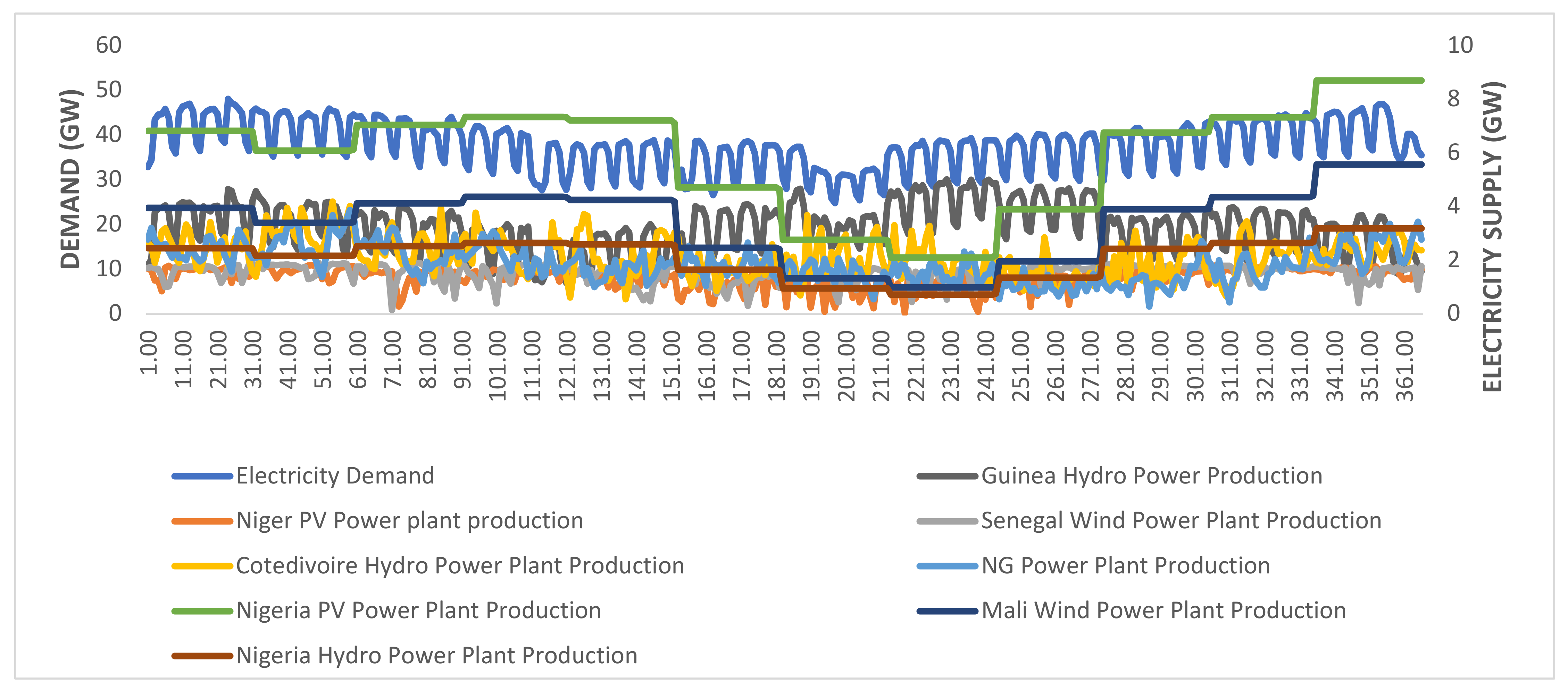In this section, the result of the simulations is presented and discussed in detail. Since none of the West African countries has total access to electricity, the results are in three stages. The first stage is for 100% access to meet the total demand for natural gas-fired power plants. The second is for the maximum RES that can be integrated into the grid without producing CEEP, concerning RES potential available in each country. The third stage is only taken into account if stage two does not meet up with the target of 48% minimum RES share. In this stage, a certain capacity of storage was incorporated to meet the target. During simulation and obtaining results, priority was given to hydropower due to less requirement of landmass and better technology reliability followed by technologies with less investment cost while considering power factor and minimizing or eliminating the use of storage system to achieve the target without CEEP. Where possible, all technologies considered in this study were integrated to improve power quality and sustainability. It is noteworthy that the results presented are not necessarily the cheapest scenario, but it is the best way found to meet the target.
3.1. Results for Individual Countries
Table 6 provides the summary of the simulation result for each West African country in terms of the combination of the technologies and in meeting the electricity demand for 2030. The scenario is the case of utilizing renewable energy in tandem with natural gas for each country. It is worth stating that in certain countries where specific RE sources are scarce, the model made the exclusion of such resources.
Table 6 is a summary result of the simulations based on the standard case of integrating 48% renewable energy into the grid system of west African countries, based on avoidance of critical excess electricity production (CEEP). The plan of the WAPP is the integration of 48% renewable energy; however, it is seen that the economic and environmental implications on the West African countries differ. This is also tied to the amount of fossil fuel needed to augment the RE sources for electricity generation. The highest renewable energy penetration was noticed in Nigeria, Ghana and Burkina Faso. The least investment in the RE integration was measured in Guniea Bissau and Gambia for the same 48% RE integration scenario.
Figure 7,
Figure 8,
Figure 9,
Figure 10,
Figure 11,
Figure 12,
Figure 13,
Figure 14,
Figure 15,
Figure 16,
Figure 17,
Figure 18,
Figure 19 and
Figure 20 show the hourly production of the RE and forecasted demand. The production of fossil fuel is non-variable; hence, it is excluded from the graphs.
Benin Republic has an estimated hydropower potential of 760 MW. Based on the simulation result, to meet its demand of 6 TWh for the year 2030 with 100% electricity access, a natural gas-fired power plant with a capacity of 1055 MW is required, which produces CO
2 emission of 2.722 Mt yearly. In order to meet the minimum 48% target, a hydro capacity of 655 MW, 155 MW capacity of PV and 100 MW of wind are required, as plotted in
Figure 7, which will reduce emissions massively down to 1.418 Mt. The total annual electricity produced by hydro, wind and PV are 2.41 TWh, 0.25 TWh and 0.22 TWh, respectively. The total investment cost and the total annual cost are estimated to be USD 5.18 billion and USD 296 million, respectively.
Burkina Faso is said to have limited potential for hydropower due to irregularity and also unfavorable hydro-meteorological conditions [
91]; therefore, it was not considered. A 1440 MW natural gas-fired power plant is required to meet the estimated demand of 8.2 TWh/year. This will produce an emission of 3.72 Mt. With the integration of wind and solar PV, only a maximum of 41% RES share could be achieved with CEEP. In order to meet the 48% minimum target, 1330 MW of natural gas, 900 MW of solar PV, 800 MW of wind and a minimum of 2 GW storage are required to be integrated to avoid CEEP. Concerning the synchronous grid system in West Africa, the consequences of CEEP are forced export (if adequate interconnection capacity does not exist). Without the integration of a storage facility, there will be CEEP. The total investment cost and total annual cost are estimated at USD 2.84 Billion and USD 220.65 million, respectively. CO
2 emissions will drop from 3.72 Mt to 1.94 Mt per year. The electricity demand and RE productions are plotted in
Figure 8.
The government is working to make the country a West African electrical hub with some of the best energy infrastructure in the region. The existing power system in Côte d’Ivoire is the third-largest in West Africa, with 76% access to electricity. Côte d’Ivoire has a total installed capacity of 2179 MW as of 2020, with around 60% of it generated by thermal power and the remaining 40% by hydroelectric dams with an installed capacity of 879 MW [
92]. The country has the potential to generate about 46 TWh/year [
80], which is twice the total demand of 23 TWh for 2030. In order to meet the demand for solely natural gas, an installed capacity of 4100 MW is required, which will produce 10.43 Mt of emission. In order to meet the target without CEEP, 2900 MW of natural gas, 2800 MW of hydro, 600 MW of PV and 5 MW of wind are required. The total investment cost and the total annual cost will amount to USD 21.25 billion and USD 1.19 billion, respectively. Moreover, CO
2 emissions will drop from 10.43 to 5.29 Mt per year. The electricity demand and RE productions are plotted in
Figure 9.
Gambia has no hydropower-generating potential [
93]; therefore, it was not considered in this research. In order to meet the total forecasted demand of 2 TWh for 2030 with only natural gas, an installed capacity of 470 MW is required, which will produce 0.9 Mt of CO
2 emission. Only 29% RES share can be achieved using PV and wind without CEEP. In order to meet the target of 48% RES share, 320 MW of natural gas, 240 MW of PV, 235 MW of wind and 1 GW of storage are required; the electricity demand and RE productions are plotted in
Figure 10. Without the integration of a storage facility, there will be CEEP. This will reduce emissions from 0.9 to 0.47 Mt per year and incur a total investment cost and a total annual cost of USD 751 million and USD 57 million, respectively.
Ghana is the country with the highest electricity access, with 85% in the region. The country has a hydropower installed capacity of 1584 MW which makes up about 40% of the total electricity generation capacity in the country, with a potential capacity of 2480 MW [
81]. Therefore, it will cost the country much less to meet the target. In order to meet the electricity demand of 47 TWh for 2030 with only natural gas, an installed capacity of 8300 MW is required and will produce an emission of 21.32 Mt.
A maximum of 33.7% RES share can be achieved without CEEP and the use of storage. An installed capacity of 6500 MW of natural gas, 2300 MW of hydro, 3000 MW of PV, 3000 MW of wind and 8 GW of storage are required to meet 48% RES share without CEEP. Total investment cost and total annual costs are USD 26.85 billion and USD 1.69 billion, respectively. CO
2 emissions will drop from 21.32 to 11.09 Mt per year. The electricity demand and RE productions are plotted in
Figure 11.
Guinea has an installed capacity of 368 MW of hydropower with an estimated potential of 6100 MW [
82]. Hydropower amount to about 75% of the total electricity generation capacity [
42]; therefore, the country is in a very good state with the minimum RES share required, but there is only about 45.7% electricity access. In order to meet the total demand of 5.3 TWh for 2030 with natural gas, an installed capacity of 950 MW is required and will produce 2.4 Mt emissions per year. Furthermore, to provide 100% electricity access and meet the RES share target, 700 MW of natural gas, 600 MW of hydro, 150 MW PV and 70 MW of wind are required. This will reduce emissions from 2.4 to 1.23 Mt. Moreover, the total investment cost and total annual costs are USD 4.96 billion and USD 288 million, respectively. The electricity demand and RE productions are plotted in
Figure 12.
Guinea-Bissau’s available hydropower potential from the rivers Corubal and Geba is estimated to be 184 MW. Even though hydropower has a great deal of potential, Guinea-Bissau has yet to make considerable use of it [
83]. A 55 MW capacity of a natural gas-fired power plant is required to meet the projected demand of 0.3 TWh, and this will produce 0.136 Mt of emission. In order to meet the target, 40 MW of natural gas, 35 MW of hydro, 6 MW of PV and 3 MW of wind are required. This will reduce emissions from 0.136 to 0.07 Mt per year and will incur a total investment cost and a total annual cost of USD 272 million and USD 14.86 million, respectively. The electricity demand and RE productions are plotted in
Figure 13.
Hydropower potential in Liberia is estimated to be 4478 MW with an installed capacity of 88 MW [
84]. In order to meet 100% electricity access of 1.4 TWh by 2030 with only natural gas power plant, an installed capacity of 250 MW is required, and this will produce 0.635 Mt CO
2 emission per year. By integrating 180 MW of natural gas, 170 MW of hydropower, 35 MW of PV and 12 MW of wind, a minimum target of 48% RES share can be achieved without CEEP. The total investment cost and total annual costs are USD 1.3 billion and USD 73.17 million, respectively. In addition, this will reduce emissions from 0.635 to 0.331 Mt per year. The electricity demand and RE productions are plotted in
Figure 14.
In order to meet Mali’s 100% electricity access of 7.4 TWh by 2030 with only a natural gas power plant, an installed capacity of 1300 MW is required, and this will produce 3.36 Mt CO
2 emission. A 48% RES share can be achieved by installing 950 MW of natural gas, 700 MW of hydro, 250 MW of PV and 200 MW of wind without CEEP. There is just over 1000 MW of hydropower potential in Mali, with an available installed capacity of 310 MW [
85]. In order to reach the target, a total investment cost and a total annual cost of USD 5.82 billion and USD 336.12 million, respectively, are required, and this will reduce emissions from 3.336 to 1.75 Mt per year. The electricity demand and RE productions are plotted in
Figure 15.
Based on the simulation result, for Niger to meet its demand of 6 TWh for the year 2030 with 100% electricity access, a natural gas-fired power plant with a capacity of 1055 MW is required, which will produce CO
2 emission of 2.722 Mt yearly. The country has an estimated hydropower potential of over 400 MW [
86]. Without CEEP and the use of storage, 46% RES share can be achieved with an installed capacity of 800 MW of natural gas, 400 MW of hydropower, 250 MW of PV and 300 MW of wind. The total investment cost and total annual costs are USD 3.85 billion and USD 224 million, respectively, which will reduce emissions from 2.722 down to 1.476 Mt per year. The electricity demand and RE productions are plotted in
Figure 16.
Nigeria, which is the largest country in the region in terms of population as well as energy demand, is estimated to have a demand of 200 TWh by 2030. In order to meet this demand with only natural gas, a capacity of 36,000 MW is required, as equally stated in previous research [
68]. A maximum of 44% RES share can be achieved without CEEP and the use of storage. The country has an installed hydropower capacity of 2110 MW, which generated 6.10 TWh of electricity in 2019. The country has a high exploitable hydropower potential estimated at 14,120 MW [
87]. An installed capacity of 27,000 MW of natural gas, 14,000 MW of hydro, 9600 MW of PV, 10,000 MW of wind and 9 GW of storage are required to meet 48% RES share without CEEP. Total investment costs and total annual costs are USD 133.93 billion and USD 8.13 billion, respectively. CO
2 emissions will drop from 90.72 to 47.18 Mt per year. The electricity demand and RE productions are plotted in
Figure 17.
Senegal is forecasted to have a total demand of 17.3 TWh by 2030, and in order to meet this target with one technology of a natural gas-fired power plant, an installed capacity of 3050 MW is required, which will produce 7.85 Mt of CO
2. Based on the simulation carried out in this study, the target of a minimum of 48% of RES share cannot be achieved without the use of storage. In order to prevent CEEP and meet the target, the integration of 2600 MW of natural gas, 1500 MW of PV, 1850 MW of wind, 2.5 GW of storage and 200 MW of hydro are required. Without the integration of a storage facility, there will be CEEP. It is noteworthy that the country has a relatively low hydropower potential of 253 MW [
88]. The total investment cost and total annual costs are USD 6.92 billion and USD 509.89 million, respectively, which will reduce emissions from 7.85 down to 4.07 Mt per year. The electricity demand and RE productions are plotted in
Figure 18.
Hydropower potential in Sierra Leone is estimated to be 2000 MW [
89]. There is currently an installed capacity of 75 MW, which generates about 66 % of the total electricity generation capacity in the country [
94]. In order to meet 100% electricity access of 1.3 TWh by 2030 with only natural gas power plant, an installed capacity of 230 MW is required and this will produce 0.59 Mt CO
2 emission per year. Hydropower alone of 150 MW can generate up to 44.8% of the demand without CEEP. By integrating 170 MW of natural gas, 150 MW of hydropower, 20 MW of PV and 4 MW of wind, the target of a minimum 48% RES share can be achieved without CEEP. The total investment cost and total annual costs are USD 1.2 billion and USD 69.74 million, respectively. Moreover, this will reduce emissions from 0.59 to 0.306 Mt per year. The electricity demand and RE productions are plotted in
Figure 19.
Togo is forecasted to have a total electricity demand of 6.3 TWh by 2030, and in order to meet this target with one technology of a natural gas-fired power plant, an installed capacity of 1120 MW is required, which will produce 2.86 Mt of CO
2. Based on the simulation process, a target of a minimum of 48% of RES share can be achieved by the integration of 950 MW of natural gas, 620 MW of PV, 710 MW of wind, 2 GW of storage and 150 MW of hydro are required, without CEEP. Without the integration of a storage facility, there will be CEEP. The country has an installed capacity of 67 MW of hydropower, which as of 2017, produces about 69% of the total electricity generated with an estimated potential of over 150 MW [
90]. The total investment cost and total annual costs are USD 3.12 billion and USD 218.36 million, respectively, which will reduce emissions from 2.68 down to 1.48 Mt per year. The electricity demand and RE productions are plotted in
Figure 20.
The table shows the technical optimization of different hybrid renewable energy for the countries considered in West Africa. The underlying basis for the modeling is to achieve the set 48% RE integration. From
Table 7, it is seen that utilizing the storage facilities eliminates the critical excess electricity, however, with higher investment cost. In the Benin Republic, the hybrid NG + PV + wind gave the least CEEP of 0.04 TWh and an investment cost of USD 2.09 billion. In Togo, the analysis shows that for implementing pumped hydro storage, with the NG + hydro + PV + wind, an additional USD 2.74 billion is required to store 0.49 TW of electricity. For Senegal, the additional cost of USD 1.64 billion is the additional investment required for pumped hydro storage to cater for the 0.94 TW of electricity. There is no substantial hydropower resource in Burkina Faso; therefore, it is excluded from the analysis. The result shows that natural gas and wind hybrid energy resource will yield 0.10 TW of CEEP, and the investment is USD 2.41 billion.
Generally, it is seen that despite the huge potential of hydropower in the West African region, it does not present an optimal feasibility for electricity production. A hybrid system utilizing the solar and wind potential in the region can help in significantly meeting the growing energy demands in a cost-effective manner.
3.2. Regional Synchronous Power Grid
The total regional electricity demand for the year 2030 is estimated to be 331.5 TWh. In order to meet this demand that will provide 100% electricity access to the region with the use of only a natural gas-fired power plant, an installed capacity of 58,500 MW is required, and this will produce CO
2 emission of 150 Mt per year. The total investment cost and total annual costs are USD 44.18 billion and USD 3.81 billion, respectively. The electricity demand and production profile for a year is plotted in
Figure 21. Despite the vast availability of natural gas resources in West African countries, their utilization will pose huge environmental effects. Moreover, it is expensive to operate. It is important to state that controlling CO
2 emissions will be difficult if 100% electricity access to the region is facilitated with the use of only a natural gas-fired power plant since natural gas production and consumption are major drivers of the economic growth of most of the West African countries [
95]. Furthermore, some limitations of natural gas are fugitive emissions [
96], infrastructure costs [
97] and limited geographical distribution.
The WAPP regional plan had only prioritized hydropower and natural gas projects [
98]. However, there is a limitation to this. The impact of drought and climate change on hydropower plants, as well as vandalism on gas pipelines, are impediments to this plan. For example, severe droughts in 1998, 2001 and 2007 caused Cote d’Ivoire, Ghana and Nigeria, which rely heavily on hydropower, to have a significant drop in electricity production, affecting electricity trade between countries. Furthermore, there is the possibility of a reduction in hydropower generation from two major rivers in the region by more than 50% between 2015 and 2050 due to climate change [
99]. Since 2012, vandalism on several gas pipelines in Nigeria has resulted in a significant decline in both Nigeria’s and Ghana’s electricity generation. However, if 1% of the estimated suitable land is utilized, the region has the potential to generate up to five times its projected demand in 2025 through solar technologies [
100]. With an enormous solar photovoltaic (PV) technical potential in the region and the vast hydropower resource, it is necessary to investigate the feasibility of solar technologies and hydropower in meeting the rapidly growing demand of an interconnected West Africa electricity network operating under the auspices of a single regional electricity market [
98].
The result shows that 44.6% of the demand can be generated through hydropower, which is approximately 93% of the 48% RES share target. The countries and capacities considered are as follows: Nigeria (14,000 MW), Cote d’Ivoire (12,000 MW), Guinea (6100 MW), Liberia (4400 MW), Ghana (2400 MW), Sierra Leone (2000 MW) and Mali (1000 MW); demand and power supply profile is plotted in
Figure 22. Even if other countries within the region are considered, their hydropower potential total is less than 2000 MW, which is still less than what is required to meet the 48% RES share target. The total investment cost and total annual costs are USD 310.49 billion and USD 17.32 billion, respectively, and this will reduce emissions from 150 to 83.3 Mt per year.
When considering only solar PV integration into the grid while avoiding CEEP, a maximum of 19% RES share can be achieved with a total installed capacity of 34,000 MW, which will reduce emissions from 150 to 122 Mt per year. Seven countries with the highest capacity factor as well as countries with larger landmass, were considered for this analysis. Therefore, when considering integrating only wind, a maximum of 25.6% RES share can be achieved with a total installed capacity of 34,500 MW and will reduce emissions to 111.9 Mt per year. Based on these findings, it is impossible to meet the target or even get close to the use of solar PV or wind alone, and this is due to their high intermittency.
According to this study and within its scope, it is only possible to meet the target if the three renewable energy technologies are integrated to avoid CEEP and the use of storage as a unified synchronous power grid.
Table 7 and
Figure 23 show the result summary of the technologies, countries, capacities and annual electricity production in this analysis and the electricity demand and supply.
The analysis was carried out for 100% electricity access and 48% renewable energy utilization, priority in renewable energy generation is given to countries with rich resources and higher potential. Furthermore, the synchronous grid system is simulated to consider the existing bilateral interconnection lines in the region, for instance, Mali–Senegal, Nigeria–Niger, Guinea–Mali and other interconnection projects within the framework of WAPP initiatives such as Nigeria, Cote d’Ivoire and Guinea to other countries [
101]. Furthermore, the inclusion criteria for renewable energy generation considered potential, capacity factor and landmass. The system will reduce emissions to 77.8 Mt per year and incur a total investment cost and a total annual cost of USD 250.37 billion and USD 14.71 billion, respectively, which is cheaper than using only hydropower.
Table 8 also presents the six countries considered for RE production, with Nigeria and the Niger Republic generating a combined capacity of 13,000 MW from solar PV; Mali and Senegal generating another combined capacity of 13,000 MW from wind; and Nigeria, Cote d’Ivoire and Guinea generating a combined capacity of 29,000 MW from hydro; all the countries put together generate 42,000 MW from natural gas.
Figure 24 shows the percentage share of renewable energy.
Figure 24 shows that the river hydro has huge potential in West Africa for power generation, as it constitutes 30% of the proposed Synchronous grid system. A study by Harald et al. [
102] investigated the hydropower potential of West Africa in detail, using precipitation and potential evapotranspiration data as input. Their result agrees with the findings of this study, as their study conclusively stated that West Africa has huge hydro potential. Furthermore, their study showed that Guinea and the southeastern parts of Nigeria have promising hydropower potential.
The creation of the West African power pool was not only to develop large regional power plants and build interconnected transmission infrastructures between the countries but also to create a unified regional electricity market [
101]. The WAPP project established the ECOWAS Regional Electricity Regulatory Authority (ERERA) in 2008 to regulate the cross-border trade of electricity in West Africa. The committee, over the years, have initiated several regulations and policies in driving the commitment to achieve electricity interconnections in ECOWAS [
103]. The implementation and installation of the synchronous electricity grid in West Africa will also have economic benefits for the regional power market in the region. Small and energy-constrained states, such as Liberia, the Gambia, Guinea Bissau, Burkina Faso, Niger and Mali, would be the primary beneficiaries of the regional energy market [
98]. These countries could save 1 to 3.5% of GDP annually by increasing their reliance on imports and, as a result, reduce their power generation costs by at least 20% [
103]. This money could then be used to fund other areas of the economy. The significantly positive outcome of the promotion of regional integration of electricity trading and investments in low-cost electricity generation options (similar to that facilitated by the synchronous grid system) can be seen from the Southern African Power Pool (SAPP) initiative. Bowen et al. [
101] explained that the benefits of centralized and competitive dispatch in SAPP could reach USD 100 million per year when compared to existing bilateral electricity trade agreements. These benefits accrue primarily as a result of increased hydropower utilization under integrated operation conditions, as currently, the statistics for the SAPP generation mix are 74.3% coal, 20.1% hydro, 4% nuclear and 1.6% diesel and gas.
